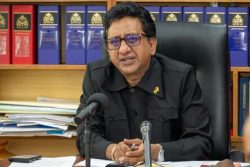The Guyana Gold and Diamond Miners Association (GGDMA) announced last evening that Medium and Small miners have declared just over 359,000 ounces of gold as of the end of November.
This is marginally less that the 387,508 ounces declared in 2014 but much less than the 481,087 ounces declared in 2013.
For the past few years, gold has been a mainstay of Guyana’s economy and the precious mineral is the largest earner of foreign exchange but declarations from small and medium-scale producers have been on the decline after some miners, confronted with a variety of factors including a drop in gold prices, exited the sector.
As they lament the low production level of what has been “a green year” for the industry, the GGDMA is calling for the Closed Area Committee (CAC) to once again be reconstituted and for a commission of inquiry similar to the one conducted into the Guyana Sugar Corporation to be launched into the activities of the Guyana Geology and Mines Commission.
Speaking at the association’s bi-monthly meeting last evening former GGDMA director Edwards Shields noted that the CAC has stopped functioning.
“As a matter of fact that committee expired as of the 31st of May 2015,” Shields declared as he noted that he had brought the “urgency of having this committee” to the attention of Minister with responsibility for mining Raphael Trotman.
“The latest report is that it has met the level of the cabinet, which is to decide on the members of the committee,” Shields told the gathered miners.
He explained that the CAC is most important as decisions made to grant alternative blocks are now in limbo. He noted that in the case of allocations of new lands for mining the committee recommends, the minister approves and informs the GGMC who then implements.
He said that several applications by miners were approved by the committee yet no letter from the Minister approving the recommendation from the committee has been forwarded to GGMC.
He expressed the opinion that concern about the environment “has taken a major role and the powers that be have decided that until they clarify the situation they won’t open more land.”
“You have over 6 million acres available of state land; 2 million from cancelled blocks and from small lotteries you have about half a million acres all tied up and people want land,” Shields said.
Last year the committee was reconstituted in the wake of falling gold productions even as it was acknowledged that identifying suitable areas for mining lotteries and auctions remains a challenge because of Amerindian land titling and extensions.
At that time Shields had explained to Stabroek News that the Closed Area Committee was established in February 1994.
Its mandate was to identify closed areas and state reserves that can be open to miners for the purpose of the location of claims, and approving applications for grants of prospecting and mining licences, prospecting permits and mining permits,” Shields had said. “Following identification of these closed areas, the Closed Area Committee was further charged with implementing the exercise in accordance with the regulations signed by the Minister. The Closed Area Committee also had the responsibility to investigate and resolve any complaints arising from this exercise,” he had added.
The Closed Area Committee was in later years further authorized to conduct lotteries and auctions in accordance with regulations, signed by the Minister for Mines. Over the years scheduling lotteries and holding auctions, after identifying properties from closed areas and state reserves, have been its main activities, Shields had said.
Shields yesterday said that miners are asking to be treated with respect. As they are not being informed of issues in the industry by the GGMC, an entity which they are finding difficult to meet with while the gold board has not met for months
Stressing that last year the royalties paid by miners was 4.8 billion dollars, Shields said that the GGDMA is asking the president to set up “a commission of inquiry with impartial people and professional people along the same lines as the sugar industry and the public service”.







